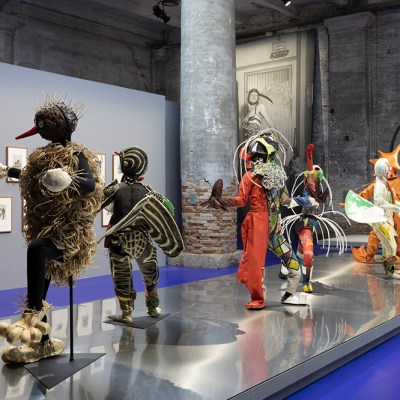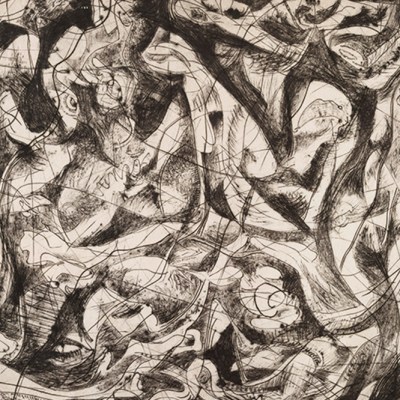From the June 2022 issue of Apollo. Preview and subscribe here.
This year marks the 25th anniversary of ‘Sensation’, the cleverly titled exhibition held at the Royal Academy featuring the work of young British artists, or YBAs as they were known, at least until they all became middle-aged. 1997 is a generation ago – and in some ways curiously quaint: readers somewhat over the age of 25 might remember a Vanity Fair magazine cover that same year promoting ‘Cool Britannia’ and declaring ‘London Swings Again.’ And much of the outrage generated by ‘Sensation’ – the likes of Damien Hirst’s shark suspended in formaldehyde and Tracey Emin’s tent, Everyone I Have Ever Slept With 1963–1995 – would now barely raise a jaded eyebrow.
The show unquestionably encapsulated a moment in British social and cultural life, but how truly representative was it of the country’s art at the time? ‘Sensation’ toured to several international venues, including the Hamburger Bahnhof in Berlin and the Brooklyn Museum in New York, and in some circles came to be perceived as embodying the best of what Britain’s artists then had to offer. However, everything featured came from the collection of one individual, Charles Saatchi, and had been selected with the involvement of the Academy’s exhibitions secretary, Norman Rosenthal. It might be said to have represented only the tastes of two men.
A similar point was made 80 years ago, in the June 1942 issue of Apollo, by the magazine’s editor Herbert Furst. At the time, an exhibition of contemporary British art was touring the United States. The collection of work, which included names as diverse as George Clausen, Augustus John, John Piper and Edward Burra, was clearly meant to give Americans an idea of various trends then prevalent. Nevertheless, Furst was right to question whether it provided visitors to the show with an insight into the state of art in Britain at the time. ‘Or does it,’ he asked, ‘rather represent the taste of one or several individuals presuming to decide what is and what is not Art?’ As far as Furst was concerned, it was clear ‘the choice has been decided by aestheticians for aestheticians, I mean persons instructed in the history and the modern developments of the art of painting.’
Poster for the ‘Sensation’ exhibition, 1997, designed by Why Not Associates, photography by Rocco Redondo and Photodisc

Of course, all exhibitions reflect the tastes and opinions of those responsible for their curation, as Furst surely understood. What seems to have riled him was an impression that the organisers were thinking more about what they might like to see than about the prospective transatlantic audience. He judged the result ‘a show for specialists’. Posing the question, ‘Does it give the American public an idea of the present state of art in Britain?’ Furst responded in the negative, ‘unless, of course, one believes that “Art” is the private ground of experts where the public are trespassers’.
Furst next looked at a couple of specific works included in the exhibition, beginning with Stanley Spencer’s The Nativity (1912; now in the collection of University College London). He concluded that many Americans would look at the painting in bewilderment, ‘wondering what it is all about, and suspecting that Mr Spencer must belong to a very peculiar sect of Christians if that is his idea of the Birth of Christ, with horse chestnuts blooming in December and inexplicable persons doing unexplained things (with the exception of one woman kneeling uncomfortably between an iron railing and a trellised wooden fence)’. Likewise he suspected William Roberts’ The Gutter (1934-5) – with its mass of brightly-coloured, angular figures – would lead to bafflement.
For Furst, while these exhibits could be considered examples of art in Britain, they were not, by themselves, sufficiently representative of contemporary British art. He thought Americans would have liked to know what kind of pictures their British equivalents favoured. Alfred Munnings, for example, who two years later became President of the Royal Academy, did not feature. Nor did the sentimental genre painter Charles Spencelayh, a favourite of Queen Mary. Provocatively, Furst also suggested political cartoonists like David Low ought to have been among the exhibitors.
‘All these things are missing from the exhibition of Contemporary British Art,’ he noted, ‘and all are needed to complete its true picture.’ It is easy to sympathise with, Furst’s point of view, but it was unrealistic. All exhibitions must involve a process of selection and rejection, and even artists who make the grade may not be happy with the work picked for exhibition. Ultimately, whether it is ‘Sensation’ in 1997 or ‘Contemporary British Art’ in 1942, a show offers as much insight into the mindset of the curators responsible as it does into the event’s ostensible theme.
From the June 2022 issue of Apollo. Preview and subscribe here.


